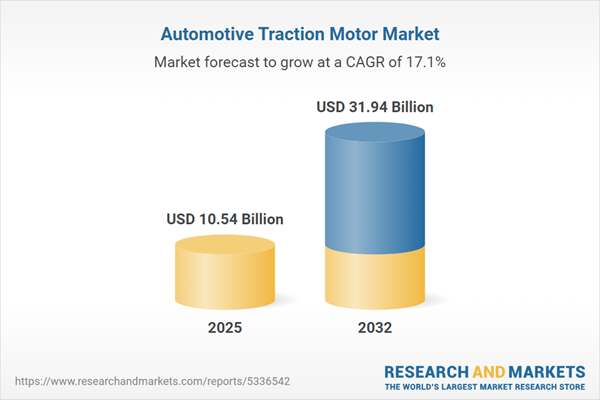Speak directly to the analyst to clarify any post sales queries you may have.
Senior executives in the automotive traction motor market must navigate rapid technology advancements, shifting international policy, and ongoing supply chain evolution. Reliable, up-to-date market intelligence is vital for shaping responsive strategies and enabling operational resilience in a transforming global automotive sector.
Market Snapshot: Automotive Traction Motor Market Growth & Outlook
The automotive traction motor market is exhibiting robust expansion, with a valuation of USD 9 billion in 2024 and projected growth to USD 10.54 billion in 2025. Looking ahead, the market is expected to reach USD 31.94 billion by 2032, representing a compound annual growth rate (CAGR) of 17.14%.
This sustained momentum is driven by continuous advancements in propulsion technology, increasing global electric vehicle uptake, and targeted investments in future-ready automotive systems. Industry players are intensifying their focus on research and development, operations modernization, and alignment with evolving compliance requirements. Electrification is now central to vehicle manufacturing strategies across diverse markets, compelling organizations to prioritize advanced propulsion integration and adherence to both regional and global policy directives.Scope & Segmentation of the Automotive Traction Motor Market
This report provides a structured and comprehensive view of critical market segments and technology drivers, enabling senior decision-makers to align investments and risk strategies effectively. Each segmentation factor presents influential considerations for executive planning and strategic focus.
- Motor Types: Covers induction motors, various permanent magnet synchronous motors, and switched reluctance motors, each affecting choices linked to efficiency, cost, and performance goals.
- Power Ratings: Includes the spectrum from below 50 kW to ranges above 100 kW, supporting application-specific investment decisions in both passenger and commercial vehicles.
- Vehicle Types: Encompasses battery electric, hybrid, plug-in hybrid, and fuel cell electric vehicles to reflect the full landscape of passenger and logistics-oriented automotive solutions.
- Speed Ranges: Addresses both low-speed transport solutions and high-speed heavy-duty fleet use, guiding engineering design and market entry tactics.
- Cooling Methods: Analyzes air- and liquid-cooled systems, helping inform operational reliability management across diverse deployment conditions.
- Vehicle Applications: Considers the integration of traction motors in passenger cars, light commercial vehicles, and larger fleet vehicles for improved operational and product planning.
- Regional Coverage: Provides trend and driver analysis across key automotive regions, including the Americas, Europe, Middle East and Africa, and Asia-Pacific, with specialized coverage of the United States, China, Germany, India, Japan, Brazil, and South Korea.
- Key Companies Profiled: Evaluates strategic moves and technological progress among major industry players, such as Robert Bosch GmbH, Aisin Corporation, Continental AG, Denso Corporation, ZF Friedrichshafen AG, BorgWarner Inc., Hitachi Astemo Ltd., Mitsubishi Electric Corporation, Tesla Inc., Valeo SA, and Schaeffler AG, providing valuable insights into competitive positioning and partnerships.
Key Takeaways: Strategic Insights for Automotive Traction Motor Market Leaders
- Advanced propulsion technologies are influencing procurement and operational models, prompting organizations to revisit lifecycle management strategies for diverse vehicle platforms.
- Innovations in component materials and improved thermal management systems are extending service lifespans while aiding in compliance with evolving environmental regulations.
- Companies are adapting supply chain strategies to ensure steady material availability, thereby improving their ability to withstand global supply disruptions and safeguarding operational continuity.
- Collaboration between automakers, technology firms, and suppliers is expediting the implementation of next-generation propulsion solutions across multiple automotive sectors.
- New digital engineering and predictive maintenance systems are supporting enhanced fleet availability, offering proactive solutions for asset upkeep and operational planning.
- Continuous regulatory monitoring enables executive teams to anticipate changes, adapt business models, and capture competitive opportunities as standards evolve globally.
Tariff Impact: Navigating Trade Policy Challenges
Recent tariff adjustments in the U.S. impacting permanent magnet motor components are leading executive teams to reassess and realign supplier bases. Regionalizing sourcing strategies is now central to maintaining profit margins, reducing risk exposure from global trade volatility, and ensuring business continuity as international policy landscapes shift.
Methodology & Data Sources
The insights leveraged in this report stem from structured interviews with industry executives, detailed supply chain mapping, and in-depth market analysis. Analytical tools such as PESTLE, Porter’s Five Forces, and scenario planning have been utilized to assess potential risks and emerging opportunities within the automotive traction motor market.
Why This Report Matters: Automotive Traction Motor Market
- Helps executives adapt propulsion strategies to ongoing technology change and heightened compliance requirements.
- Facilitates effective benchmarking and anticipatory planning for evolving supplier networks and regional market variances.
- Strengthens the ability of leadership teams to identify early trends, supporting robust operational agility and informed investment decisions.
Conclusion
Staying competitive in the automotive traction motor market requires a focus on progressive technologies, operational efficiency, and rigorous supply chain management. Proactive leadership and agile response mechanisms are vital for achieving sustainable growth amid ongoing industry transformation.
Additional Product Information:
- Purchase of this report includes 1 year online access with quarterly updates.
- This report can be updated on request. Please contact our Customer Experience team using the Ask a Question widget on our website.
Table of Contents
3. Executive Summary
4. Market Overview
7. Cumulative Impact of Artificial Intelligence 2025
Companies Mentioned
The companies profiled in this Automotive Traction Motor market report include:- Robert Bosch GmbH
- Aisin Corporation
- Continental AG
- Denso Corporation
- ZF Friedrichshafen AG
- BorgWarner Inc.
- Hitachi Astemo, Ltd.
- Mitsubishi Electric Corporation
- Tesla, Inc.
- Valeo SA
- Schaeffler AG
Table Information
| Report Attribute | Details |
|---|---|
| No. of Pages | 191 |
| Published | October 2025 |
| Forecast Period | 2025 - 2032 |
| Estimated Market Value ( USD | $ 10.54 Billion |
| Forecasted Market Value ( USD | $ 31.94 Billion |
| Compound Annual Growth Rate | 17.1% |
| Regions Covered | Global |
| No. of Companies Mentioned | 12 |









